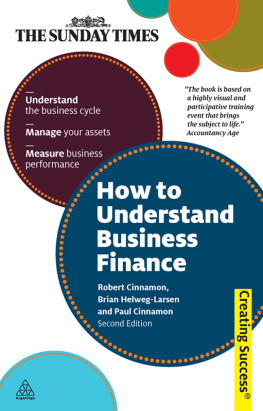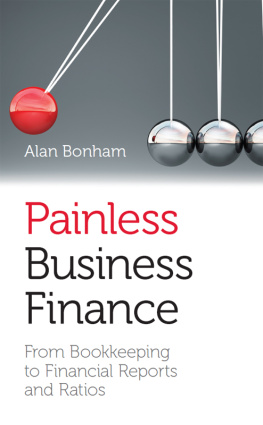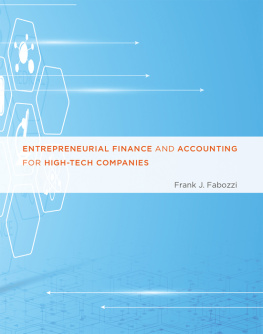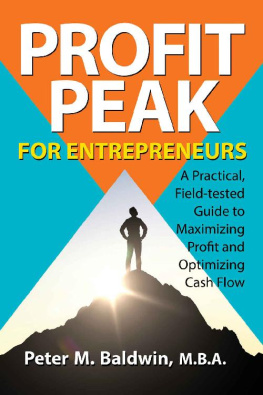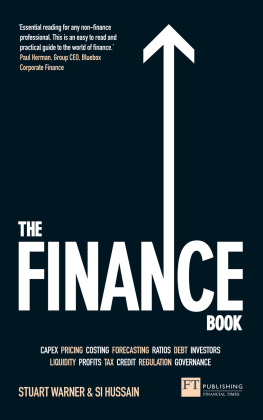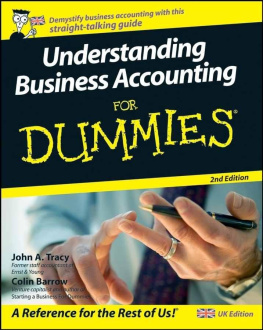
How to
Understand
Business
Finance
Robert Cinnamon, Brian Helweg-Larsen
and Paul Cinnamon
Second Edition

Publishers note
Every possible effort has been made to ensure that the information contained in this book is accurate at the time of going to press, and the publishers and authors cannot accept responsibility for any errors or omissions, however caused. No responsibility for loss or damage occasioned to any person acting, or refraining from action, as a result of the material in this publication can be accepted by the editor, the publisher or any of the authors.
First published in Great Britain in 2002 by Kogan Page Limited entitled If Youre So Brilliant How Come You Dont Understand Your Accountant?
Reissued in 2005 entitled How Come You Dont Understand Your Accountant?
Reissued in 2006 entitled How to Understand Business Finance
Second edition 2010
Apart from any fair dealing for the purposes of research or private study, or criticism or review, as permitted under the Copyright, Designs and Patents Act 1988, this publication may only be reproduced, stored or transmitted, in any form or by any means, with the prior permission in writing of the publishers, or in the case of reprographic reproduction in accordance with the terms and licences issued by the CLA. Enquiries concerning reproduction outside these terms should be sent to the publishers at the undermentioned addresses:
120 Pentonville Road
London N1 9JN
United Kingdom
www.koganpage.com | 525 South 4th Street, #241
Philadelphia PA 19147
USA | 4737/23 Ansari Road
Daryaganj
New Delhi 110002
India |
Robert Cinnamon, Brian Helweg-Larsen and Paul Cinnamon, 2002, 2006, 2010
The right of Robert Cinnamon and Brian Helweg-Larsen to be identified as the authors of this work has been asserted by them in accordance with the Copyright, Designs and Patents Act 1988.
ISBN 978 0 7494 6020 4
E-ISBN 978 0 7494 6021 1
The views expressed in this book are those of the authors, and are not necessarily the same as those of Times Newspapers Ltd.
British Library Cataloguing-in-Publication Data
A CIP record for this book is available from the British Library.
Library of Congress Cataloging-in-Publication Data
Cinnamon, Robert.
How to understand business finance / Bob Cinnamon, Brian Helweg-Larsen. -- 2nd ed.
p. cm.
ISBN 978-0-7494-6020-4
1. Business enterprises--Finance. 2. Financial statements. I. Helweg-Larsen, Brian. II. Title.
HG4026.C526 2010
658.15--dc22
2009045602
Typeset by Saxon Graphics Ltd, Derby
Printed and bound in India by Replika Press Pvt Ltd
eBook by Graphicraft Limited, Hong Kong
Contents
Writing a book is a daunting task. I must firstly thank Professor Malcolm McDonald who told us that as a training consultant I should write books. Next, my colleague Peter Cheverton has provided an exemplary role model and inspired me to write a book on something I know a little about finance for non-financial managers.
As an engineer by background I attended countless finance programmes, but it was not until I came across a hands-on business simulation that I really got to grips with the subject. The simulation was so effective that not only was I converted, but its models are now the basis of all my explanations on financial matters. A big thank you must therefore go to Nigel Downing and Brian Helweg-Larsen of ProfitAbilityBusiness Simulations for providing such an excellent mechanism for conveying in simple terms the sometimes difficult concepts of finance.
Lastly I thank my publisher Kogan Page for having the faith in me to produce a worthwhile book.
Robert Cinnamon
bob@cinnamon-ltd.com
I would like to thank Gordon Cousins for encouraging me to study, and then teach finance, and for working with me on the original ProfitAbilitydesign; Nigel Downing, for many years of friendship, working with me on Enterprise ProfitAbility and building the business we run today; and my wife Sarah for her endless patience and total support.
Brian Helweg-Larsen
brian@profitability.com
Many parts of this book build on the business game Enterprise ProfitAbility, developed by ProfitAbilityBusiness Simulations. You will see a pictorial representation of the finances of a business in if you find this helpful.
Readers who have a basic understanding of finance can dip in and out of the book at will. Others may find it helpful to read first before moving on to more complex topics.
Inevitably, different elements of finance overlap. So, if you do not understand a concept mentioned in one part of the book, check to see if it is explained more fully elsewhere.
Ask a group of business people why they need to know about finance and accounting, or more to the point, why they want to know about it, and the answers can be rather revealing. Most people say, I just want to know what they (the accountants) are talking about.
This covers a variety of confusions from the abundant use of jargon (do you know your EBIT from your PBIT?), to the incomprehension over apparently arbitrary conventions (and yes, some are just arbitrary conventions ). The more vigorous the complaint, the more such comments betray a deeper problem. Typically, it is a face-saving way of saying that they dont really understand the principles of financial and management accounting. That includes reading a balance sheet can you? And knowing how it differs from a profit and loss account do you?
A variation and sophistication on this first response is, Id like to be able to understand why what happens to me, happens to me.
I have heard a marketing director say, The finance folk are a team along the corridor who reject my proposals.
I have heard a production manager ask, Why is it that the CFO always wins when we are discussing budgets?
The general cry of, It isnt fair, when business people are confronted by their accountants, rises to a deafening climax when times are tough and cutbacks are required.
After these initial, and often rather bitter, responses, the more thoughtful will start to say that what they really want is the confidence to challenge their accountants assertions.
The marketing director wants to know why she is always told that she spends her budget too quickly, and, more importantly, does she really?
The sales director wants to know why he is told to press customers to stick to their payment terms, or even to offer discounts for early payment, when what the customer really wants is extended credit, and in any case that big sales opportunity is just getting warm.
The operations director is told that he is sitting on too much stock, yet the salespeople always explode when they run out of something. What he wants to know is, whats the problem, and whats too much?
The buyer is pressed to ask suppliers for improved terms but what she would much prefer is for those suppliers to do her some real favours on developing new products. Whos right, the buyer or the accountants, and how could they discuss the pros and the cons of each approach?
Once you are able to discuss such questions, not only do the scales fall from the eyes but you are ready to move on to the next level of sophistication actively managing your own financials.

